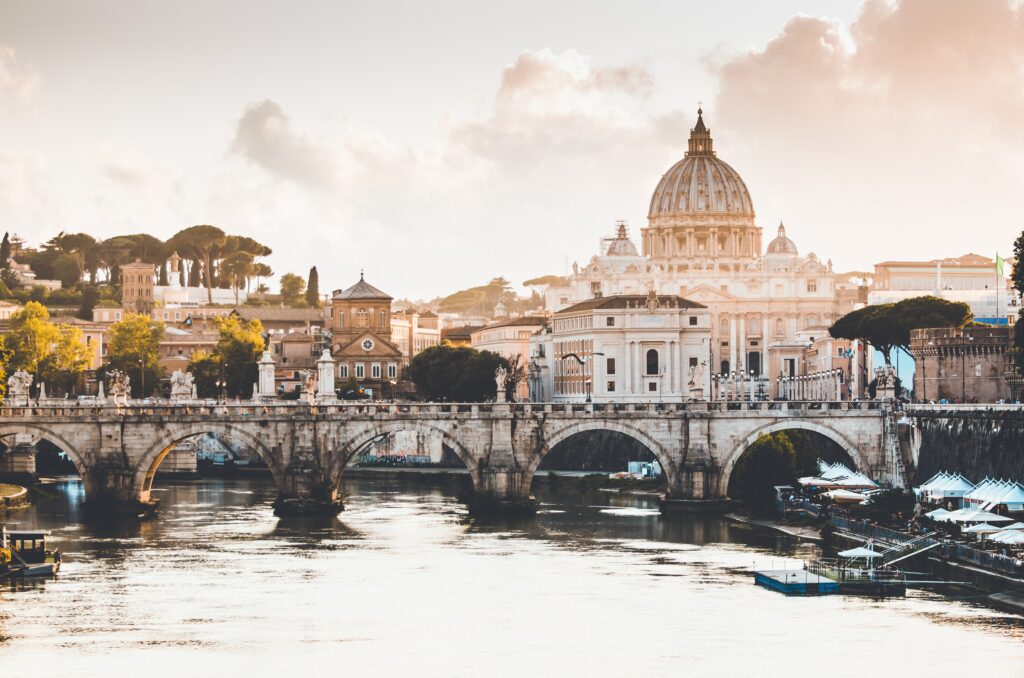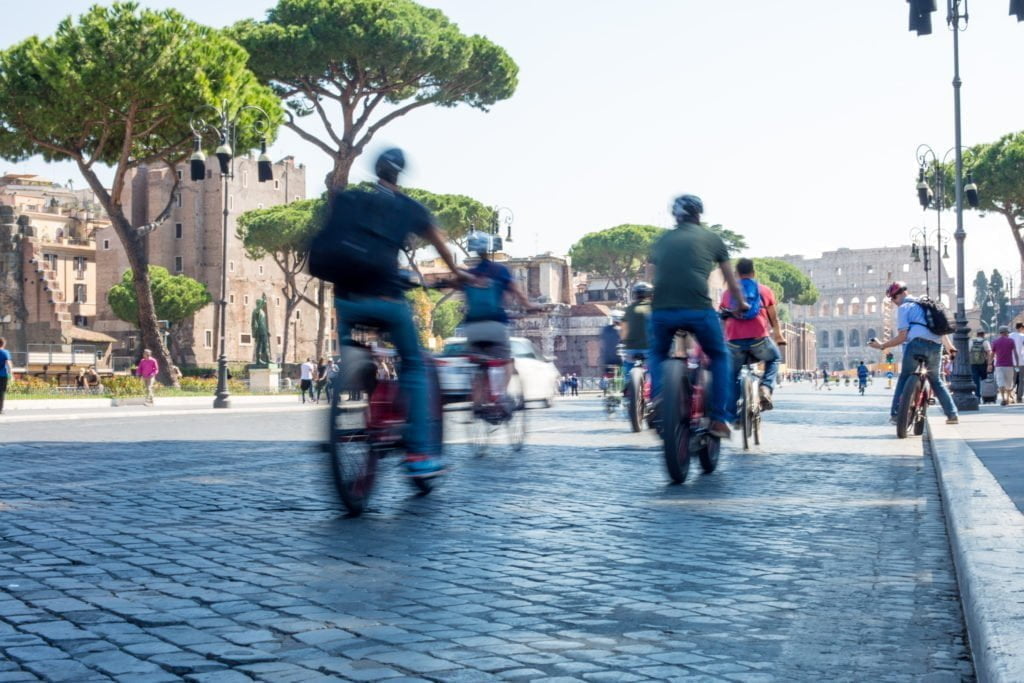Relaunching mobility in Rome: Interview with Enrico Stefàno, City of Rome
In this interview, our associate member TRElab (Transport Research Laboratory of the University of Roma Tre), speaks to Enrico Stefàno, Chairman of the Transport Committee of the city of Rome and member of the CIVITAS Political Advisory Committee. TRElab leads the Logistics Living Lab of Rome and has coordinated the freight section of Rome’s Sustainable Urban Mobility Plan. The interview is also available in podcast format (in Italian).
Like the rest of Italy, the municipality of Rome is preparing to face the so-called Phase 2 at the end of the national lockdown, scheduled for 4th May. Among the various strategic issues that the Roman administration is facing, the transport sector certainly stands out. Indeed, many are wondering what measures will have to be taken to put in place safe and efficient, but also sustainable, mobility for all citizens.
Thanks to the platforms that we are all learning to use in this period of home-working, on 17th April the Transport Committee of Rome was able to meet with many key actors including the Public Transport Operator (ATAC), the National Association of Italian Municipalities (ANCI), the Italian Environment and Bicycle Federation, the Road Safety Committee, the National Union of Foreign Vehicle Representatives and other environmental and safety associations. The objectives of the Transport Committee are oriented towards the development of a strategy that makes Rome a sustainable, accessible, livable city, as declared by Enrico Stefàno on his social channels at the end of the meeting. We thank him for being our guest to discuss the relationship between urban mobility and COVID-19 and the implications for the city of Rome.
President Stefàno, how is the city of Rome dealing with this period of emergency related to coronavirus with regards to the movement of people and goods?
ES: The city of Rome has reacted promptly, also in compliance with the decrees of the Prime Minister and the consequent ordinances of the Lazio Region. Having to manage a lower demand, the public transport service has been remodelled, both reprogramming journeys similarly to the basic summer service and anticipating the last trips at 9pm, in compliance with the regional regulations. Already before the lockdown, the public transport operators, ATAC and Roma TPL, had implemented precautionary measures such as the sanitation of vehicles and a safety distance for drivers. Clearly, it is a very difficult phase that we hope to overcome soon, but I believe that the city of Rome and our investee companies responded promptly and efficiently.
With reference to the so-called Phase 2, what are the most significant interventions and the objectives resulting from the meeting of the Transport Committee on 17 April? Are they in line with the guidelines set by the SUMP?
As far as Phase 2 is concerned, we are outlining a series of scenarios and then we will have a definitive framework once the national rules are decided. Clearly, public transport will not immediately be able to satisfy the demand it used to meet, it is unthinkable to guarantee access to 90-100 people on a bus or 1,200 on the subway. It will therefore be necessary to act promptly and decisively. On the one hand, the demand for transport and travel must be reduced upstream, continuing with the positive experience of home-working and video-conferencing, both for the local administration and the companies in the city. For those who still need to move, we are outlining a series of sustainable, effective and efficient alternatives. The private car, although it seems an attractive or safe solution, cannot be the answer, because we would risk congesting our roads.
The analyses developed by Roma Servizi per la Mobilità (Rome mobility agency) on the data collected during the past year show that a large part of the movements in the city are reduced as regards their temporal extension. Consequently, we will immediately create and strengthen sustainable alternatives such as safe cycling and pedestrian routes, and we will re-launch inter- and multi-modal alternatives that are going well in our city. I am thinking of the experiences with bike or mopeds sharing, but also with the e-scooters that is a service that we are going to launch soon and could partially fill a demand for transport that should be redistributed at different times.
There is a risk that many citizens will decide to use only private vehicles for fear of contagion. How can you go about making people feel safe on public transport and not to return, or even exceed, the pre-lockdown pollution levels? An essential role will be played by effective communication towards citizens and businesses.
Communication and citizens’ awareness are extremely important aspects. Up to now, we all have scrupulously respected some rules; I think, for example, of the non-crowding of supermarkets, of all us queuing diligently to do the shopping. The same will have to be done when using public transport and therefore respecting the distance, the other rules and all protective devices that will be imposed on citizens.
We are also preparing a plan to verify and fix a quota for the access to public transport, but in an extended city like Rome, 8,500 bus stops and 100 metro stops cannot be constantly monitored. Therefore, citizens' awareness will play an important role, as has been the case up to now, and to understand how everyone’s behaviour can put at risk themselves but also and above all other people.
As regards urban logistics, the crisis has shown that this represents an essential service to ensure that supermarkets are constantly supplied and that home deliveries decrease the number of citizens' movements. In this sense, have you talked about sector-specific measures in the Transport Committee? The Logistics Living Lab will facilitate discussion with stakeholders.
An important aspect of this crisis is that, despite its drama, it has allowed us to draw experiences and lessons: one of these is certainly the key role of urban logistics in our city and the need to reorganise this service. We had already started upstream with an important work done together with universities and with our planners and designers in the framework of the SUMP, which highlights how strategic this sector is for our city and how important it is to make it work effectively and efficiently.
Also in this case, as for virtuous and sustainable behaviours for the mobility of people, this crisis gives us the opportunity to accelerate the transition towards sustainable behaviours for the movement of goods, and therefore to accelerate the implementation of that plan that already we had arranged last year based on a long-term vision.
Finally, the National Association of Italian Municipalities (ANCI) is coordinating the mobility councillors of the main Italian municipalities, in order to send proposals to the national government with measures that can be activated immediately by the municipalities. Turin and Milan seem to go in the same direction as Rome. Are you optimistic about this collaboration?
Yes, I must say the work of ANCI is always precious and important, a coordination work between all local authorities. Without a single coordination it would be much more difficult. We are comparing and coordinating with the other Italian municipalities, while recalling the peculiarities of the city of Rome, which has a territory that is not very comparable in terms of population, extension and number of employees and services with other Italian cities.
However, even a trivial and simple comparison such as preparing an act or tackling a specific problem which then occurs on different scales is certainly important. Collaboration with other major cities has always been important for Rome; even more at this stage, it is essential that municipalities give a coordinated and unambiguous response. It would also be an important message for our national system.



